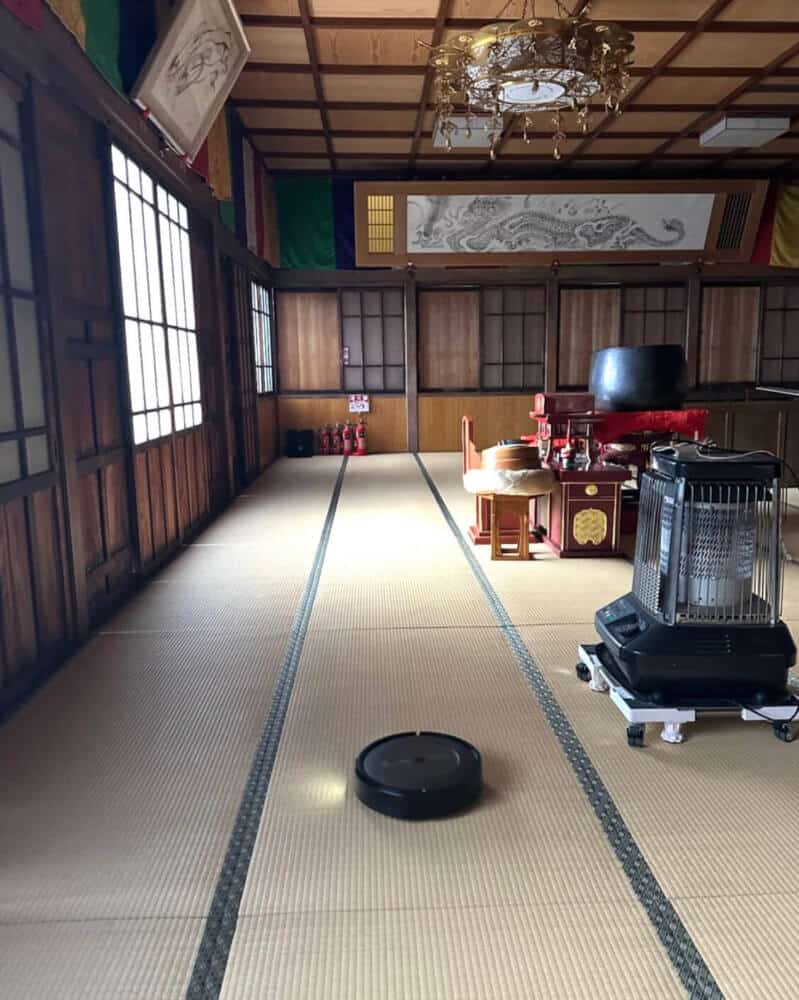Kanda Shrine, nestled near Akihabara, shows us a remarkable blending of the past and the present.
Established on its current grounds since 1616, the shrine is not just a historical monument but also a fitting neighbor to Akihabara—the heartland of Japan’s pop culture and technology.
Recent Events:
- The shrine recently invited a fleet of robotic vacuum cleaners, Roombas, during its susuosame ceremony, a traditional cleaning ritual.
- Usually priests and miko (shrine maidens) perform the cleaning, but this time, these modern helpers glided across the floors, contributing significantly to the tidiness of the shrine.
Page Contents
Modern Day Roombas Help Prepare The Kanda Shrine For Annual Susuosame Ceremony
Kanda Myojin has a history of engaging with contemporary culture. Collaborations have included popular entities such as Studio Ghibli and gaming giant PlayStation.

A striking demonstration of this blend happened during the susuosame ceremony, where Roombas operated alongside shrine personnel.

The initiative was met with positivity, and the performance of the Roombas even garnered affectionate appreciation from shrine representatives.
It seems that the shrine is open to adopting new practices that may eventually become part of the tradition itself.
By incorporating technology into rituals, a dialogue is created between preserving old ways and embracing new ideas.
The initiative has shown that it’s possible to honor and maintain time-honored traditions while still adopting modern advancements. Kanda Myojin’s approach might suggest that traditions are living things, capable of evolving with society’s progress.
With Akihabara’s tech-driven backdrop, the shrine continues to adapt, reflecting on the notion that spirituality and technology can coexist harmoniously.
The Susuharai Ceremony’s Role in Shinto
Susuharai, or the annual cleaning ceremony, is a significant ritual in the Shinto faith. It represents purification, preparing sacred spaces for the New Year by clearing away the dust and impurities of the past year.
This ceremony is a meaningful way to honor the kami, or Shinto gods, ensuring that shrines like Kanda Myojin are a clean, welcoming place for both deities and visitors.

Robotics in Modern Religious Customs
In contemporary religious practices, robots are beginning to take on roles that include tasks typically performed by humans.
My familiarity with this topic comes from observing how Shinto shrines have been adapting robots like Roombas for tasks such as cleaning, reflecting a fusion of tradition and modernity.
Highlights of Annual Shinto Shrine Cleanings
- Timing: Conducted at the end of the year.
- Purification: A symbolic gesture for a fresh start.
- Community: Often a collective effort by shrine priests and local volunteers.
- Renewal: Preparation for the upcoming festivities.
My writing focuses on the various aspects of Japanese lifestyle, from traditional tea ceremonies and flower arrangement to modern fashion trends and pop culture. Through my articles, I aim to share my passion for Japan and provide readers with a glimpse into the rich and diverse world of Japanese culture.
I believe that the key to understanding Japanese lifestyle is to appreciate the balance between tradition and innovation. While Japan has a rich cultural heritage that dates back centuries, it is also a country that is constantly evolving and embracing new ideas and technologies.
Whether you’re interested in learning about the latest fashion trends in Tokyo, or want to explore the ancient art of calligraphy, my writing will take you on a journey through the many facets of Japanese lifestyle. So join me as we explore the beauty and complexity of this fascinating culture together!





